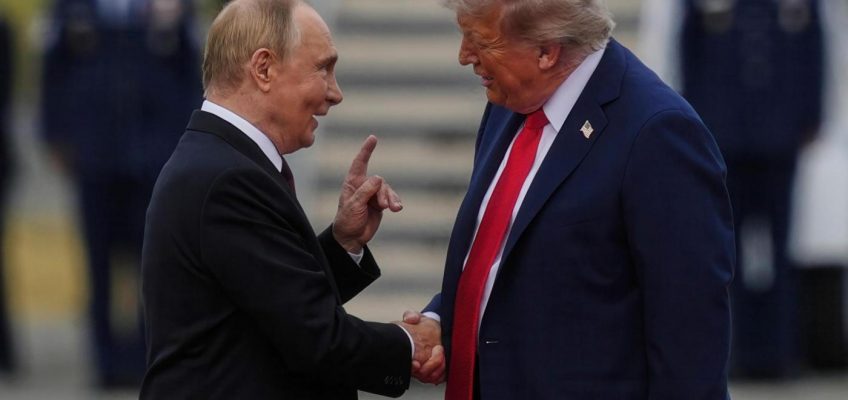By BARRY HATTON and KATIE MARIE DAVIES, Associated Press
The second Oval Office meeting in six months between U.S. President Donald Trump and Ukrainian President Volodymyr Zelenskyy went off smoothly Monday, in sharp contrast to their disastrous encounter in February.
European leaders joined the discussions in a show of transatlantic unity and both they and Zelenskyy repeatedly thanked Trump for his efforts to end Russia’s three-year war on Ukraine.
Related Articles
Thank you, Mr. President. Zelenskyy deploys gratitude diplomacy for second visit to Oval Office
Police escort Texas Democrats to prevent new redistricting walkout as California moves to retaliate
Gabbard says UK scraps demand for Apple to give backdoor access to data
Appeals court overturns order that stripped some protections from pregnant Texas state workers
Maine police officer arrested by ICE agrees to voluntarily leave the country
“I don’t want to hide the fact that I wasn’t sure it would go this way,” German Chancellor Friedrich Merz said in Washington. “But my expectations were not just met, they were exceeded.”
But despite the guarded optimism and friendly banter among the leaders, there was little concrete progress on the main obstacles to ending the war — and that deadlock likely favors Russian President Vladimir Putin, whose forces continue to make steady, if slow progress on the ground in Ukraine.
“Putin cannot get enough champagne or whatever he’s drinking,” Gabrielius Landsbergis, a former foreign minister of Lithuania, said of Monday’s meeting.
As NATO Secretary-General Mark Rutte told Fox News: “All the details have to be hammered out.”
Here is a look at the issues that need to be resolved:
Security guarantees for Ukraine
To agree to a peace deal with Russia, Ukraine wants assurances that it can deter any future attacks by the Kremlin’s forces.
President Donald Trump meet with Ukraine’s President Volodymyr Zelenskyy in the Oval Office at the White House, Monday, Aug. 18, 2025, in Washington. (AP Photo/Julia Demaree Nikhinson)
That means, Zelenskyy says, a strong Ukrainian army that is provided with weapons and training by Western partners.
It could potentially also mean offering Ukraine a guarantee resembling NATO’s collective defense mandate, which sees an attack on one member of the alliance as an attack on all. How that would work is not clear.
Additionally, Kyiv’s European allies are looking to set up a force that could backstop any peace agreement in Ukraine.
A coalition of 30 countries, including European nations, Japan and Australia, have signed up to support the initiative, although the role that the U.S. might play in such a force is unclear.
European leaders, fearing Moscow’s territorial ambitions won’t stop in Ukraine, are keen to lock America’s military might into the plan.
Trump said he’ll help provide protection but stopped short of committing American troops to the effort, instead promising U.S. “coordination.”
Russia has repeatedly rejected the idea of such a force, saying that it will not accept NATO troops in Ukraine.
British Prime Minister Keir Starmer and French President Emmanuel Macron co-chaired an online meeting Tuesday of the coalition countries.
Once officials have discussed proposals in more detail, Rutte said, a virtual meeting will take place with Trump and European leaders.
Agreeing on a ceasefire
Ukraine and its European supporters have repeatedly called for a ceasefire while peace talks are held.
Putin has balked at that prospect. With his forces inching forward in Ukraine, he has little incentive to freeze their movement.
In this photo provided by Ukraine’s 65th Mechanized Brigade press service, recruits practice military skills on a training ground on a sunflower field in the Zaporizhzhia region, Ukraine, Monday, Aug. 11, 2025, (Andriy Andriyenko/Ukraine’s 65th Mechanized Brigade via AP)
Ahead of his meeting with the Russian leader last week, Trump threatened Russia with “severe consequences” if it didn’t accept a ceasefire. Afterward, he dropped that demand and said it was best to focus on a comprehensive peace deal — as Putin has pushed for.
Trump said in Monday’s Oval Office meeting with Zelenskyy that a ceasefire between Russia and Ukraine was “unnecessary.” But after his closed-door meeting with European leaders and Zelenskyy, Trump told reporters that “all of us would obviously prefer the immediate ceasefire while we work on a lasting peace.”
Where Trump ultimately falls on that issue is important because it could affect how much Ukrainian land Russia has seized by the time the two sides get around to hammering out how much it could keep.
Occupied Ukrainian territory
Zelenskyy and European leaders said that Putin has demanded that Ukraine give up the Donbas, an industrial region in eastern Ukraine that has seen some of the most intense fighting but that Russian forces have failed to capture completely.
Ukrainian soldiers from air-defence unit of 59th brigade fire at Russian strike drones in Dnipropetrovsk region, Ukraine, Sunday, Aug. 10, 2025. (AP Photo/Evgeniy Maloletka)
Moscow’s forces also hold Crimea as well as parts of six other regions — all adding up to about one-fifth of Ukraine.
Zelenskyy has long noted the Ukrainian Constitution prohibits breaking up his country. He has also suggested the demand for territory would serve as a springboard for future invasion.
Rutte said the possibility of Ukraine ceding occupied territory to Russia in return for peace wasn’t discussed in Monday’s talks. That is an issue for Zelenskyy and Putin to consider together, he said to Fox News.
A Putin-Zelenskyy meeting
Zelenskyy has repeatedly suggested sitting down with Putin, even challenging the Russian leader to meet him as part of direct peace talks between the two sides in Turkey in May. Putin snubbed that offer, saying that significant progress on an agreement would have to be made before the pair met in person.
On Monday, Trump appeared to back Zelenskyy’s plan. “I called President Putin, and began the arrangements for a meeting, at a location to be determined, between President Putin and President Zelenskyy,” Trump said in a social media post.
He said he would join the two leaders afterward.
But when discussing a phone call held after the meeting between Trump and the Russian leader, Putin’s foreign affairs adviser Yuri Ushakov gave no indication that either a bilateral or a trilateral meeting with Ukraine had been agreed.
European leaders know that Putin doesn’t want to meet Zelenskyy and that he won’t allow Western troops in Ukraine — but they’re expressing optimism that these things could happen in the hopes of forcing Putin to be the one to say no to Trump, according to Janis Kluge of the German Institute for International and Security Affairs.
“Europeans hype up expectations to create a reality in which Putin disappoints,” he wrote on X.
___
Associated Press writers Sam McNeil in Brussels and Emma Burrows in London contributed.
___
Follow AP’s coverage of the war in Ukraine at https://apnews.com/hub/russia-ukraine



